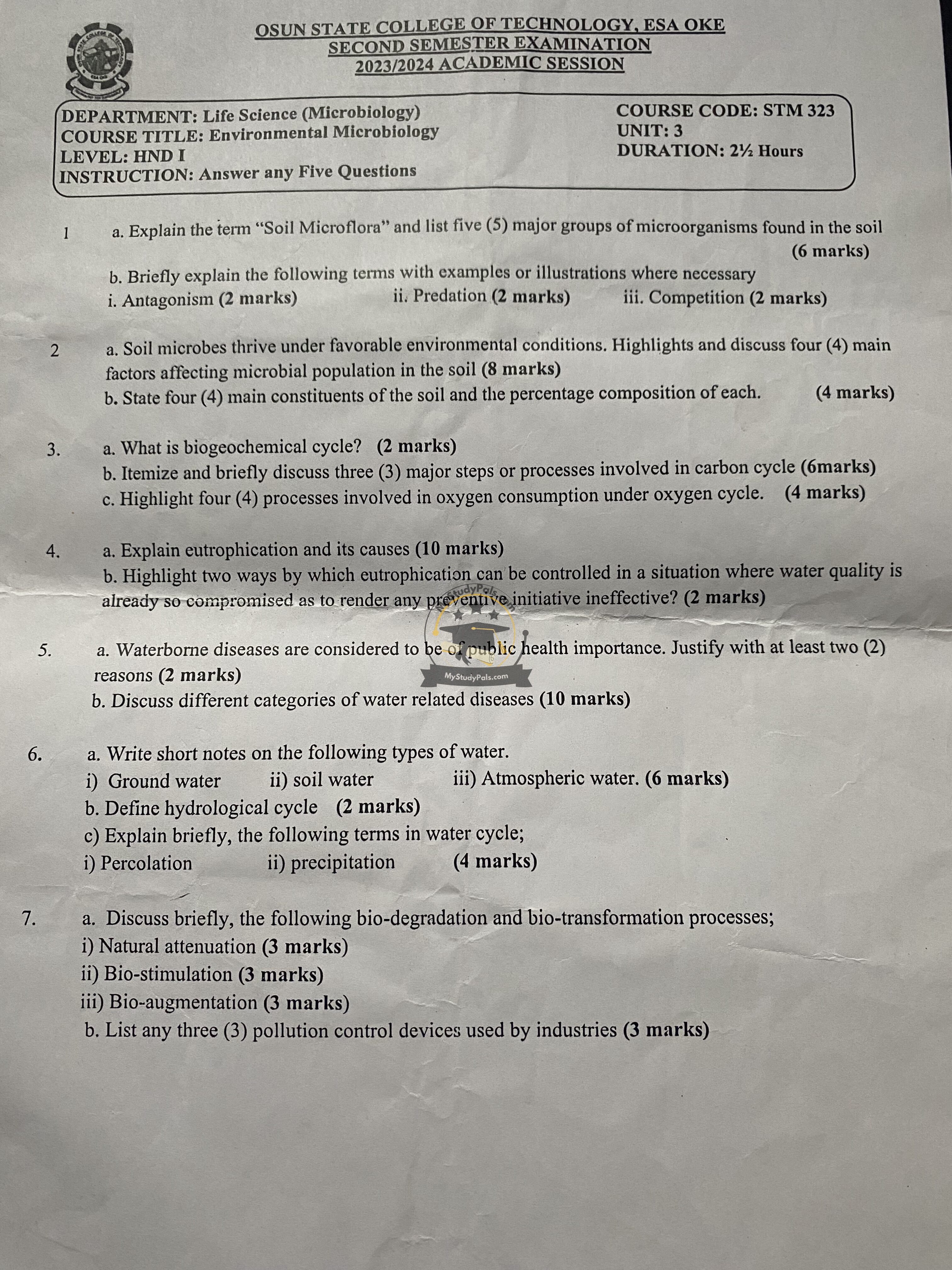ANWSER
Question 1:
a. Explain the term “Soil Microflora” and list five (5) major groups of microorganisms found in the soil.
Answer: Soil microflora refers to the community of microscopic organisms, including bacteria, fungi, algae, protozoa, and viruses, that live in the soil and contribute to nutrient cycling and soil health.
Major groups of microorganisms in the soil:
- Bacteria
- Fungi
- Actinomycetes
- Protozoa
- Algae
b. Briefly explain the following terms with examples or illustrations where necessary:
i. Antagonism (2 marks)
Answer: Antagonism is an interaction in which one microorganism inhibits the growth of another. Example: Penicillium fungi produce penicillin, which inhibits bacterial growth.
ii. Predation (2 marks)
Answer: Predation occurs when one microorganism consumes another. Example: Bdellovibrio bacteriovorus preys on Gram-negative bacteria.
iii. Competition (2 marks)
Answer: Competition is when two or more microorganisms compete for the same nutrients or space in an environment. Example: Bacteria and fungi competing for organic matter in the soil.
Question 2:
a. Soil microbes thrive under favorable environmental conditions. Highlight and discuss four (4) main factors affecting microbial population in the soil (8 marks).
Answer:
- Moisture Content – Adequate water is necessary for microbial growth and metabolic activities.
- Temperature – Optimal temperatures (25-35°C) support microbial enzymatic activities.
- Nutrient Availability – Organic matter and minerals influence microbial growth and diversity.
- pH Level – Soil pH affects microbial metabolism; bacteria prefer neutral pH, while fungi tolerate acidic pH.
b. State four (4) main constituents of the soil and the percentage composition of each. (4 marks)
Answer:
- Mineral Particles – 45%
- Organic Matter – 5%
- Water – 25%
- Air – 25%
Question 3:
a. What is a biogeochemical cycle? (2 marks)
Answer: A biogeochemical cycle is the natural process by which elements and compounds are cycled between the biotic and abiotic components of the environment.
b. Itemize and briefly discuss three (3) major steps or processes involved in the carbon cycle (6 marks).
Answer:
- Photosynthesis – Plants convert CO₂ into organic matter.
- Respiration – Organisms release CO₂ back into the atmosphere through metabolism.
- Decomposition – Microorganisms break down dead organisms, releasing carbon.
c. Highlight four (4) processes involved in oxygen consumption under the oxygen cycle. (4 marks)
Answer:
- Respiration – Oxygen is used by organisms to produce energy.
- Decomposition – Microbes consume oxygen while breaking down organic matter.
- Combustion – Burning fossil fuels and organic matter consumes oxygen.
- Oxidation of Minerals – Oxygen reacts with metals and minerals in the environment.
Question 4:
a. Explain eutrophication and its causes (10 marks).
Answer: Eutrophication is the excessive enrichment of water bodies with nutrients, leading to the overgrowth of algae and depletion of oxygen.
Causes:
- Excessive use of fertilizers
- Industrial waste discharge
- Sewage and wastewater effluents
- Agricultural runoff
b. Highlight two ways by which eutrophication can be controlled in a situation where water quality is already so compromised as to render any preventive initiative ineffective. (2 marks)
Answer:
- Aeration – Introducing oxygen to improve water quality.
- Chemical Treatment – Using algaecides to reduce algal blooms.
Question 5:
a. Waterborne diseases are considered to be of public health importance. Justify with at least two (2) reasons (2 marks).
Answer:
- They spread easily through contaminated drinking water.
- They cause widespread illness and outbreaks, affecting large populations.
b. Discuss different categories of water-related diseases (10 marks).
Answer:
- Waterborne Diseases – Caused by ingestion of contaminated water (e.g., cholera, typhoid).
- Water-Washed Diseases – Caused by lack of clean water for hygiene (e.g., trachoma, scabies).
- Water-Based Diseases – Caused by parasites that live in water (e.g., schistosomiasis).
- Water-Related Insect Vector Diseases – Transmitted by insects that breed in water (e.g., malaria, dengue fever).
Question 6:
a. Write short notes on the following types of water (6 marks).
i. Groundwater: Water stored underground in aquifers.
ii. Soil Water: Water present in soil pores, used by plants.
iii. Atmospheric Water: Water in the form of vapor, clouds, and precipitation.
b. Define the hydrological cycle (2 marks).
Answer: The hydrological cycle describes the continuous movement of water between the atmosphere, land, and oceans.
c. Explain briefly the following terms in the water cycle (4 marks).
i. Percolation: The movement of water through soil and rock layers.
ii. Precipitation: Water released from clouds as rain, snow, or hail.
Question 7:
a. Discuss briefly the following bio-degradation and bio-transformation processes:
i. Natural Attenuation (3 marks)
Answer: A natural process where microorganisms break down contaminants without human intervention.
ii. Bio-stimulation (3 marks)
Answer: Enhancing microbial activity by adding nutrients or oxygen to speed up biodegradation.
iii. Bio-augmentation (3 marks)
Answer: Introducing specific microorganisms into a contaminated site to degrade pollutants.
b. List any three (3) pollution control devices used by industries (3 marks).
Answer:
- Scrubbers – Remove pollutants from industrial exhaust gases.
- Electrostatic Precipitators – Trap particulate matter from emissions.
- Activated Carbon Filters – Absorb hazardous chemicals from air and water.


